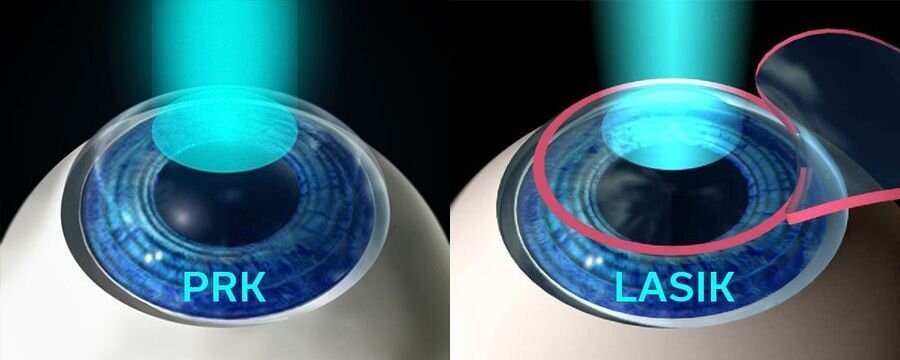LASIK VS PRK: A COMPREHENSIVE GUIDE TO LASER EYE SURGERY
LASIK vs PRK: A Comprehensive Guide to Laser Eye Surgery
With the aim of empowering you to make informed decisions about your eye health, Dr. David Gunn provides a comprehensive comparison of LASIK and PRK, two premier laser eye surgeries. Both procedures have helped countless individuals regain their sight, yet each comes with unique characteristics. Let's delve into the procedural differences, recovery times, and lifestyle considerations of LASIK and PRK.
LASIK AND PRK: UNDERSTANDING THE BASICS
LASIK (Laser-Assisted in Situ Keratomileusis) and PRK (Photorefractive Keratectomy) are advanced refractive surgeries designed to correct common vision problems such as myopia (nearsightedness), hyperopia (farsightedness), and astigmatism. Both procedures involve reshaping the cornea, the clear front part of your eye, allowing light to be accurately focused onto the retina for clear vision.
THE LASIK PROCEDURE: EFFICIENCY AND SPEED
During LASIK, Dr. Gunn creates a thin flap on the cornea, lifts it to reshape the underlying corneal tissue with a precise laser, then repositions the flap. The procedure is typically quick, often completed in under 20 minutes, and is generally painless due to numbing eye drops.
One of the significant advantages of LASIK is its quick recovery time. Many patients notice an immediate improvement in vision after surgery, and most can return to their normal activities within a day or two. However, it's recommended to avoid strenuous activities and water sports for at least a week to allow optimal healing.
THE PRK PROCEDURE: AN ALTERNATIVE APPROACH
PRK, while slightly older than LASIK, remains a highly trusted option for vision correction. Unlike LASIK, PRK doesn't involve creating a corneal flap. Instead, Dr. Gunn removes the outer layer of the cornea, known as the epithelium, then reshapes the underlying tissue using a laser. The epithelium naturally regrows over the following few days.
Due to the different approach, the recovery period for PRK is typically longer than LASIK, often taking a week or two before the patient can return to normal activities. Despite a longer recovery period, PRK can provide excellent visual results comparable to LASIK.
PRK may be a preferred option for those with thinner corneas, dry eyes, or certain other corneal conditions, as it eliminates the need for a corneal flap.
The main difference between PRK and LASIK is the creation of a flap.
LASIK VS PRK: LIFESTYLE CONSIDERATIONS
Whether you opt for LASIK or PRK, both surgeries can significantly enhance your quality of life by improving your vision. However, your lifestyle and personal preferences might make one procedure more appealing.
If you're seeking a quicker recovery and shorter downtime, LASIK might be more suitable. On the other hand, if you have certain pre-existing conditions like thinner corneas or dry eyes, PRK might be a better choice due to its unique approach.
MAKING AN INFORMED DECISION WITH DR. DAVID GUNN
Choosing between LASIK and PRK requires careful consideration. To make an informed decision, schedule an in-depth eye assessment with Dr. David Gunn. With years of experience and a commitment to providing personalised care, Dr. Gunn can determine your eligibility for laser eye surgery and recommend the best procedure based on your specific needs and lifestyle.
By embracing laser eye surgery, you can start a new chapter in life, one filled with clear, unaided vision. Dr. David Gunn and his team in Brisbane are committed to providing the highest standard of care, leveraging cutting-edge technology and a patient-centric approach to help you achieve your vision goals.
HOW DO I FOUND OUT MORE?
Read more about Laser Eye Surgery here.
About your Surgeon
DR DAVID GUNN - OPHTHALMOLOGIST
MBBS (Hons I), BSc, CertLRS, FRANZCO
Dr. David Gunn, a respected ophthalmologist based in Brisbane, specialises in managing corneal diseases, cataract surgery, and advanced laser and refractive eye procedures at the Queensland Eye Institute. He graduated with First Class Honours from the University of Queensland and was awarded the prestigious K.G. Howsam gold medal during his ophthalmology training.
As an innovator in his field, Dr. Gunn has a special interest in topographic laser eye surgery procedures. His introduction of the Corneal Allogenic Intrastromal Ring Segment surgery to Australia in May 2021 stands as testament to his drive for innovation, putting him among a select few surgeons worldwide performing this technique.
Beyond his clinical work, Dr. Gunn contributes to future developments in ophthalmology as a senior lecturer at the University of Queensland and through his active engagement in eye disease research.
However, what truly defines Dr. Gunn's work is his unwavering dedication to patient care. His pursuit of innovation and commitment to education all aim towards one goal: to enhance the lives of his patients through exceptional eye care. For Dr. Gunn, improving vision means improving life, a philosophy that continues to guide his practice in Brisbane.




